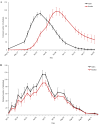Different ecological demands shape differences in population structure and behaviour among the two generations of the small pearl-bordered fritillary
- PMID: 38426142
- PMCID: PMC10903349
- DOI: 10.7717/peerj.16965
Different ecological demands shape differences in population structure and behaviour among the two generations of the small pearl-bordered fritillary
Abstract
The population structure and behaviour of univoltine butterfly species have been studied intensively. However, much less is known about bivoltine species. In particular, in-depth studies of the differences in population structure, behaviour, and ecology between these two generations are largely lacking. Therefore, we here present a mark-release-recapture study of two successive generations of the fritillary butterfly Boloria selene performed in eastern Brandenburg (Germany). We revealed intersexual and intergenerational differences regarding behaviour, dispersal, population characteristics, and protandry. The observed population densities were higher in the second generation. The flight activity of females decreased in the second generation, but remained unchanged in males. This was further supported by the rate of wing decay. The first generation displayed a linear correlation between wing decay and passed time in both sexes, whereas the linear correlation was lost in second-generation females. The proportion of resting individuals in both sexes increased in the second generation, as well as the number of nectaring females. The choice of plant genera used for nectaring seems to be more specialised in the first and more opportunistic in the second generation. The average flight distances were generally higher for females than for males and overall higher in the first generation. Predictions of long-distance movements based on the inverse power function were also generally higher in females than in males but lower in the first generation. Additionally, we found protandry only in the first but not in the second generation, which might correlate with the different developmental pathways of the two generations. These remarkable differences between both generations might reflect an adaptation to the different ecological demands during the flight season and the different tasks they have, i.e., growth in the spring season; dispersal and colonisation of new habitats during the summer season.
Keywords: Boloria selene; Butterflies; Ecological interaction; Mark-release-recature; Nature conservation; Resource use; Trait-off.
©2024 Sing et al.
Conflict of interest statement
The authors declare there are no competing interests.
Figures






References
-
- Baguette M. Long distance dispersal and landscape occupancy in a metapopulation of the cranberry fritillary butterfly. Ecography. 2003;26:153–160. doi: 10.1034/j.1600-0587.2003.03364.x. - DOI
-
- Baguette M, Vansteenwegen C, Convi I, Neve G. Sex-biased density-dependent dispersal in a metapopulation of the butterfly Proclossiana eunomia. Acta Oecologica. 1998;19:17–24. doi: 10.1016/S1146-609X(98)80004-0. - DOI
-
- Bartonova A, Benes J, Konvicka M. Generalist-specialist continuum and life history traits of Central European butterflies (Lepidoptera) - are we missing a part of the picture? European Journal of Entomology. 2014;111(4):543–553. doi: 10.14411/eje.2014.060. - DOI
-
- Bellebaum J, Köppen U, Grajetzky B. Ermittlung von Überlebenswahrscheinlichkeiten aus Ringfunddaten. Vogelwarte. 2010;48:21–32.
MeSH terms
LinkOut - more resources
Full Text Sources

